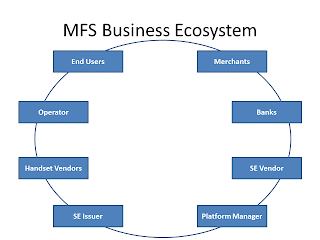The mobile financial services ecosystem is an interesting combination of traditional financial players; such as banking institutions and merchants, and more recent players; such as handset providers and mobile security providers. As of now the major players included in this ecosystem can be seen in a cyclical relationship. The major players in the ecosystem are merchants, banks, security element vendors, platform managers, security element issuers, handset vendors, operators, and lastly the end users. Please see figure 1. for an illustrated view of this ecosystem. In this ecosystem, it is up to each player to help create an environment in which stakeholders the supply chain achieves a good balance between competitive freedom and strategic dependencies to assure a wide scale uptake of mobile financial services. [1]
Figure 1.
Although each player in this supply chain is not equally important, mobile financial services will not be able to move forward unless each link is equally committed to the advancement of mobile financial services. As the saying goes, a chain is only as strong as its weakest link. In the MFS supply chain there are two links that may not be the weakest, but they are certainly important if the industry is able to move forward on a commercial level. These two players are the Security Element Vendor and Security Element Issuer. The one common theme when discussing mobile payments with the end consumer is the issue of security. Many end users are afraid that if they lose their phone then someone will have access to all of their banking information. This in turn limits the number of banks and merchants that are willing to invest in the mobile payment industry. This is a cycle that the current investors in the MFS ecosystem are attempting to avoid. This security element is an element I will discuss in more detail in a later post.
[1] Mobile Financial Services, Business Ecosystem Scenarios & Consequences. Choudhary, Bishwajit and Risikko, Juho. 2006
